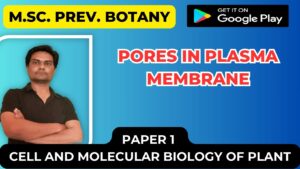![]()
Molecular Model of Plasma membrane
(i) Lipid Monolayer Model Of Langmuir-
- The first scientific attempt to know the membrane was made by someone who suggested that the membrane was composed of phospholipid of one molecule thick.
- It was shown by an experiment in which the phospholipid was spread on water.
- This forms a layer of one molecule thick on the water surface.
- Phospholipid are known as amphiphilic molecules which contain both hydrophilic & hydrophobic regions
- .Langmuir interpreted his model that hydrophilic or head groups of the lipid molecules remain attached to the water surface and the hydrophobic tails remain free towards the air.

(ii) Lipid Bilayer Model Of Gorter & Grendel-
- Gorter & Grendel proposed a lipid bilayer model of membrane structure from the experiments of RBCs. When lipid extracted from RBC’s where spread on the water surface,
- It was found that lipids were also spread as one layer on water.
- But it covers twice the area on the water surface than that the area of the cell from which lipid is extracted.
- The model of Gorter & Grendel gives a new impetus to membrane research as they first tried to describe the structure of membrane at the molecular level.

(iii) The Danielli-Davson Model-
- They concluded that the biological membrane could not be of lipid alone. Danielli & Davson proposed a molecular model of the membrane in which hydrophilic groups of the lipid molecules are covered on both sides by a protein layer .
- The proteins are attached to the hydrophilic head groups by lipid bilayer by ionic bonds .
- But in this model , the distance between ends of the fatty acid chains (hydrophobic tails) is not specified .

(iv) Robertson’s Model Or Unit Membrane Hypothesis:–
- The presence of common structure in all biological membranes led to the postulate Unit membrane hypothesis .
- For detailed study of the membrane structure & its molecular organization , Robertson selected myelin as its experimental sample .
- He selected myelin rather than the typical membrane because in case of myelin , multiple layers of membrane are present which forms quasi-crystalline structure .
- He carried out investigations on electron microscopes using different stains for lipids & proteins .
- He found that both lipid & proteins are present in the membrane .
- Lipid are present in two layers covered by proteins with lipid head groups projecting outward towards both membrane surfaces .
- Robertson’s observation corroborates the structure proposed by Danielli & Davson .
- The electron microscopic observations & X-rays diffraction data confirmed the Danieli & Davson model of membrane structure . .

(v) Fluid Mosaic Model–
- In this model the main component is the lipid bilayer with hydrophilic groups oriented towards the outside & the hydrophilic groups towards the inside of the layer .
- The basic requirement for the basic requirements of the molecular organization of the membrane is free energy.
- The term fluid is given because the lipid layer is present in the fluid state.
- The transition of the fluid layer from non fluid (gel) conditions to a liquid crystalline (fluid) state depends on the temperature of the cell.
- According to this model, proposed by SJ Singer & John Nicholson, the principle of membrane organization is as follows:
1. Lipids are present in two layers.
2. Proteins are arranged in two ways:
a) Some are embedded in lipid layer, called integral proteins &
b) Some are present on the surface of the lipid bilayer, called the peripheral proteins.
3. The lipid layer is usually in the liquid crystal line, i.e., fluid state. .

FUNCTION
- It forms protective covering over cytoplasmic organelles.
- It is selectively permeable in nature which allows only selectable molecules to pass through it.
- Substances that pass through it by simple diffusion,facilitated diffusion and by active transport method.
- Simple diffusion drives the net movement of dissolved solutes as well as water molecules and the process is termed as osmosis.
- Facilitated diffusion refers to the assisted movement of a substance down its electrochemical gradient.
- Active transport is carried out by membrane transport proteins.



